Wall Street earnings season for Q1 2024 begins this week. Traders will be offered the first reports from major US financial companies on Friday this week, before the opening of the cash session on Wall Street. JPMorgan (JPM.US), Citigroup (C.US) and Wells Fargo (WFC.US) will be the first large US banks to report results.
How was Q1 2024 for banks?
The first quarter for 2024 has been a mixed period for lenders. On one hand, higher interest rates compared to a year ago period increased their revenue from lending. On the other hand, a quick increase in rates over the past quarters caused banks to pass those increases onto deposit rates, increasing costs. Also, the prospect of interest rates staying higher for longer is causing customers and business to refrain from taking on loans, while demand for deposits is increasing along with a pick-up in deposit rates. As a result, most of the big US banks are expected to report year-over-year declines in revenue, net interest income as well as earnings per share for the first quarter of 2024.
Source: Bloomberg Finance LP, XTB
In the later part of the analysis we will focus on 7 major US banks - JPMorgan, Citigroup, Wells Fargo, Goldman Sachs, Bank of America, US Bancorp and Morgan Stanley. The first three will report results this Friday, while the remaining four will publish Q1 financials next week.
End of net interest margin expansion?
A combined data on the trailing 12-month net interest income for the 7 major US banks, as well as net interest margin data, was presented on the chart below. While combined net interest income of the group is at the highest level in history, the same cannot be said about net interest income, which has plateaued after a few quarters of increases.
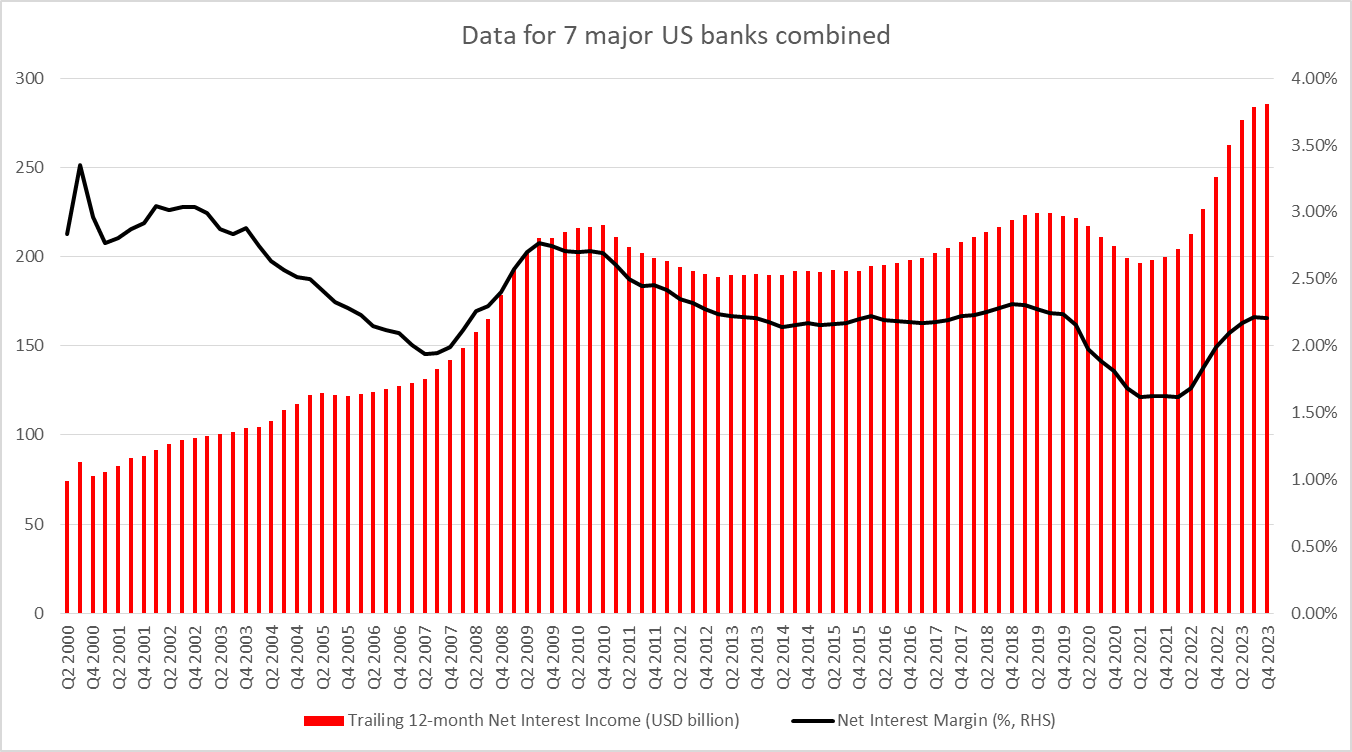 Source: Bloomberg Finance LP, XTB Research
Source: Bloomberg Finance LP, XTB Research
Those increases were driven by rising market rates as well as rising policy rates. As one can see on the chart above, income and margins began to deteriorate at the turn of 2019 and 2020 as the world was entering Covid-19 pandemic and central bank responded with massive easing. Profits and margins began to recover at the beginning of 2022 when post-pandemic rate hike cycle began. However, how close is the correlation between interest rates and banks' net interest margins?
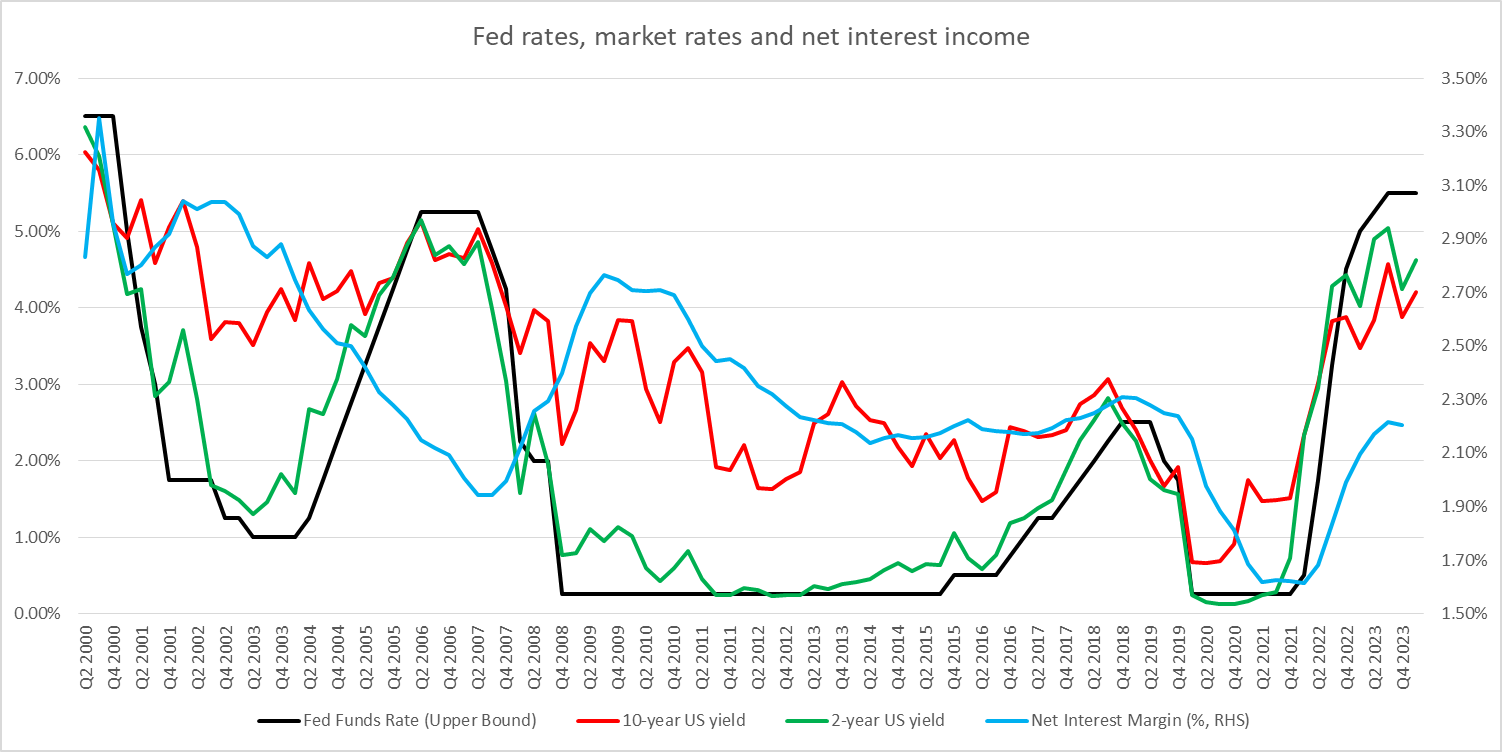 Source: Bloomberg Finance LP, XTB Research
Source: Bloomberg Finance LP, XTB Research
Net interest margins for the group of 7 analyzed banks were plotted against official Fed policy rate, as well as 2- and 10-year US yields on the chart above. As one can see, correlation between policy rates and bank margins is quite strong, especially since the global financial crisis. Bank's margins lag changes in market and policy rates, but overall direction is aligned. Net interest margins seem to be the most correlated with 2-year yields. While Fed kept rates unchanged throughout Q1 2024, market rates ticker higher slightly.
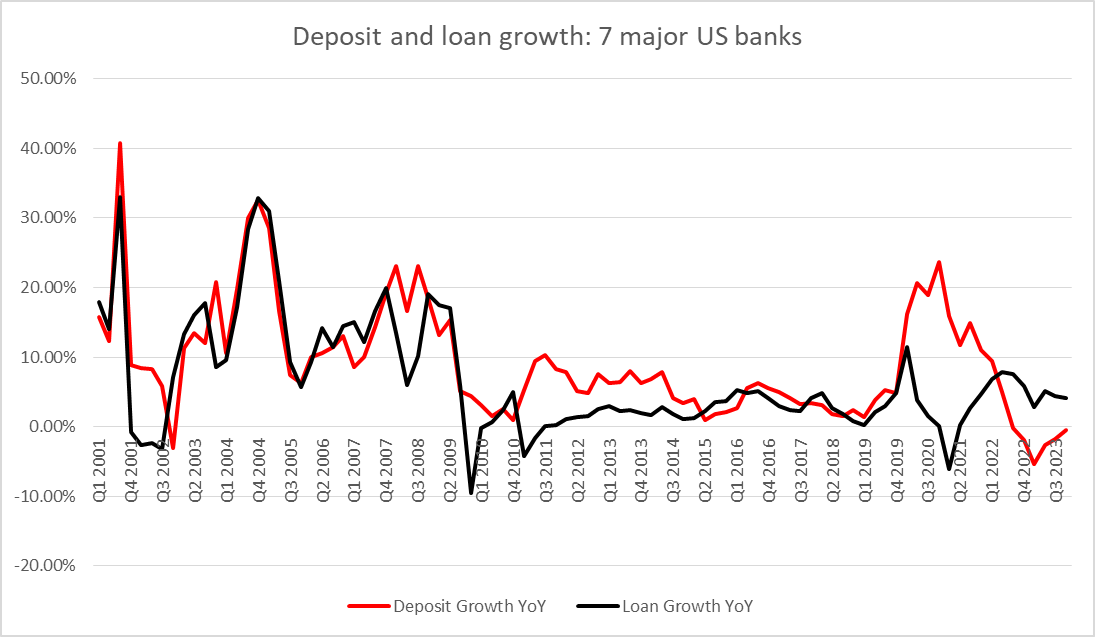 Source: Bloomberg Finance LP, XTB Research
Source: Bloomberg Finance LP, XTB Research
Taking a look at year-over-year growth rates in combined deposit and loans for the 7 major US banks, we can that while they moved in tandem for the majority of time since 2000, the situation has changed after beginning of Covid-19 pandemic in early-2020. Interestingly, deposit growth accelerated while loan growth decelerated, leading to a drop in net interest income. This was somewhat counterintuitive, as lower rates should attract loans and discourage deposits. The situation began to reverse in 2021 with deposit growth decelerating and loan growth picking-up. However, another reversal in trends occurred in the second half of 2023. Deposit growth is expected to emerge from negative territory, while high interest rates continue to put brakes on loan growth.
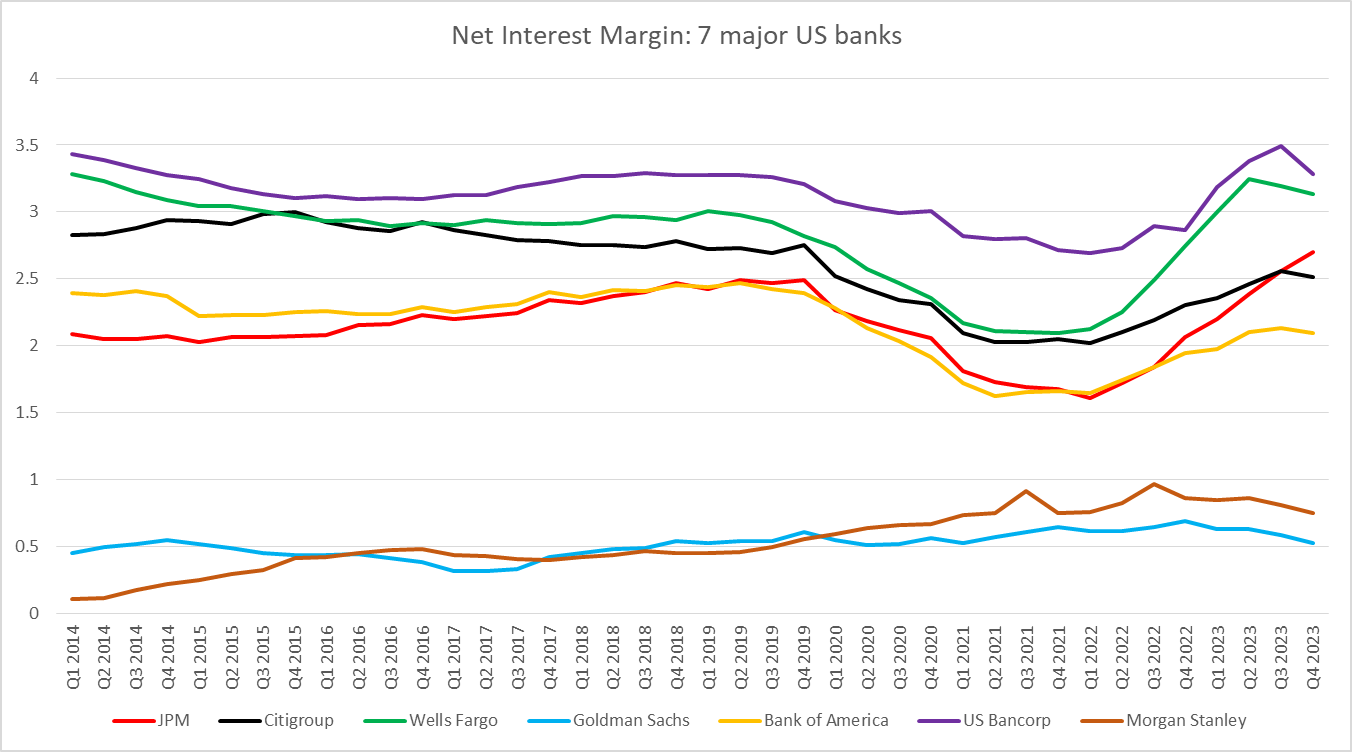 Source: Bloomberg Finance LP, XTB Research
Source: Bloomberg Finance LP, XTB Research
However, an important note is needed - not all banks are the same. In fact, their business can differ significantly. Such is also the case within the group of 7 banks we are analyzing. A chart below plots net interest margins for those 7 banks for the past 40 quarters. As one can see, two banks stand out - Morgan Stanley and Goldman Sachs have much lower margins than the group. This is because those two banks focus primarily on investment banking, while the others are more universal.
What investors will focus on?
Having the above in mind, investors will pay a close attention to banks' lending business and how their margins evolved. On one hand, keeping rates higher for longer may increase pressure on the economy and boost risk of 'hard landing', which would see loss on loans. On the other hand, the fact that Fed is keeping rates higher for longer means that apart from seeing a bumpy inflation path ahead, the central bank also sees US economy as performing well, what is evidenced by still-strong jobs data. This resilience of the US economy as well as increased likelihood of rates staying higher for longer may lead to upward revisions to the net interest income guidance.
Current 2024 guidance
- JPMorgan: Net interest income about $90 billion
- Bank of America: Q1 net interest income around $13.9-14.0 billion, with Q2 being down a bit more
- Wells Fargo: Potential for 7-9% drop in net interest income
- Citigroup: Expects net interest income excluding-markets to be down modestly compared to 2023
We have mentioned losses on loans should the economy deteriorate and face a 'hard landing'. While risk of US recession have greatly diminished recently, it remains a potential risk to watch. Having said that, data on provisions for credit losses will be watch closely. It should be noted that Q4 2023 saw a big increase in those, with combined provisions for bad loans from 7 banks we are analyzing jumping to almost $10 billion, the highest level since the 2020 pandemic spike. Should we exclude Covid-19 pandemic, which was a 'black swan' event, provisions in Q4 2023 were the highest since Q4 2011. Continued increase in those will boost concerns over real condition of the economy and may put pressure on stocks.
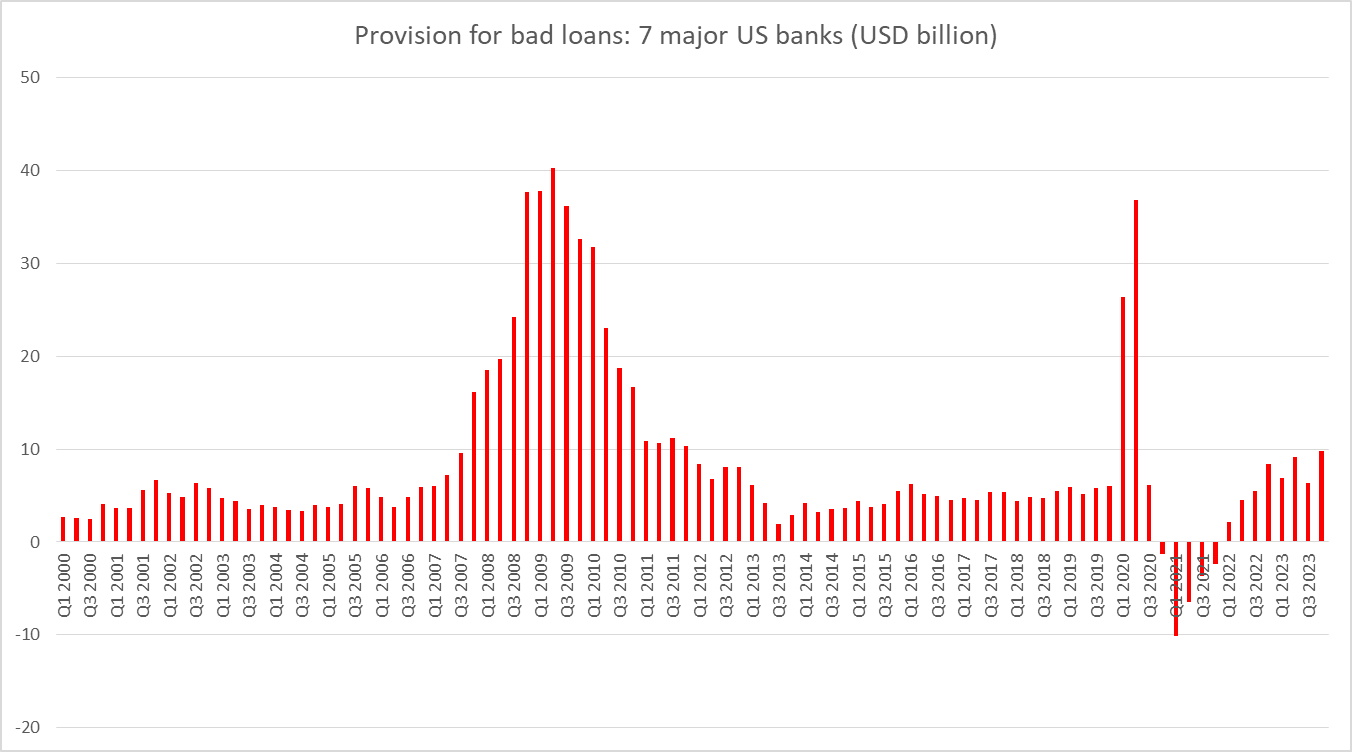 Source: Bloomberg Finance LP, XTB Research
Source: Bloomberg Finance LP, XTB Research
US banks have been outperforming broader market this year
The first quarter of 2024 was a period of moderate gains on the stock markets. Banks have been performing exceptionally well compared to broad market during the first three months of the year. S&P 500 Banks subindex gained over 10% since the beginning of the year. Meanwhile, S&P 500 index gained around 8%, while Dow Jones added around 2%. Whether this upbeat sentiment towards the sector last will depend on the upcoming earnings.
Should banks boost their guidance as well as does not report any big increase in provisions for bad loans, sentiment towards the sector may remain upbeat. However, given that there is a lot of uncertainty over the rate path in the United States, and this uncertainty has been growing recently, there is a chance that the bank may decide to maintain their conservative guidance. Lack of upward guidance revisions combined with bigger provisions for loan losses may put pressure on banking shares.
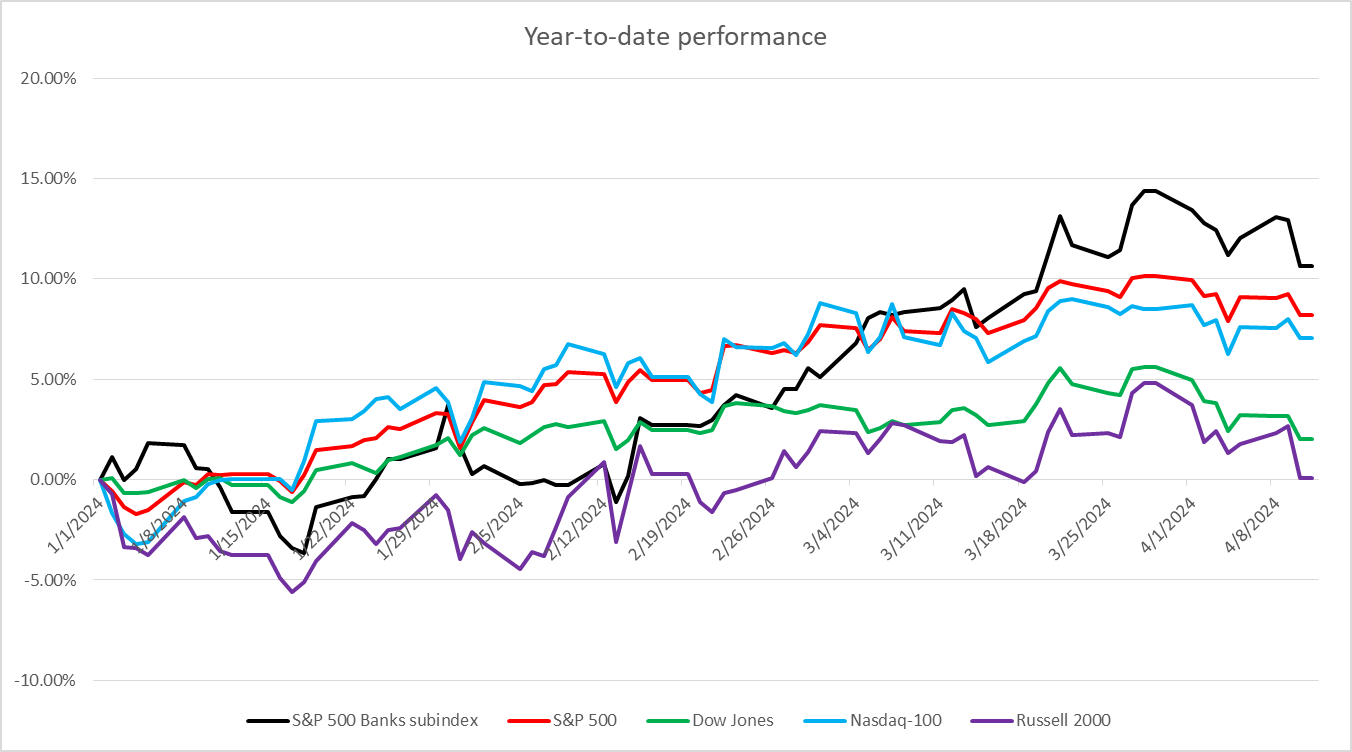 Source: Bloomberg Finance LP, XTB Research
Source: Bloomberg Finance LP, XTB Research
Alibaba sell-off extends amid White House national security concerns📌
US Earnings Season Summary 🗽What the Latest FactSet Data Shows
US Open: US100 initiates rebound attempt 🗽Micron shares near ATH📈
Micron Surges on Record DRAM Pricing
This content has been created by XTB S.A. This service is provided by XTB S.A., with its registered office in Warsaw, at Prosta 67, 00-838 Warsaw, Poland, entered in the register of entrepreneurs of the National Court Register (Krajowy Rejestr Sądowy) conducted by District Court for the Capital City of Warsaw, XII Commercial Division of the National Court Register under KRS number 0000217580, REGON number 015803782 and Tax Identification Number (NIP) 527-24-43-955, with the fully paid up share capital in the amount of PLN 5.869.181,75. XTB S.A. conducts brokerage activities on the basis of the license granted by Polish Securities and Exchange Commission on 8th November 2005 No. DDM-M-4021-57-1/2005 and is supervised by Polish Supervision Authority.


